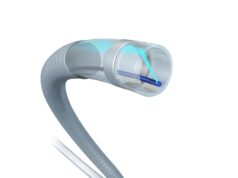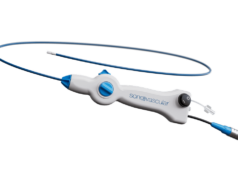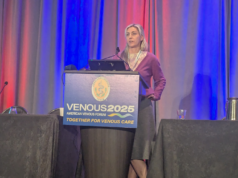 “Occasionally, taking a step in a different direction can pave the way for substantial strides forward,” Erin Murphy, MD, tells Venous News, recalling her discovery of the venous world and a defining moment in her career. In this interview, the director of the venous and lymphatic program at Atrium Health’s Sanger Heart and Vascular Institute in Charlotte, North Carolina, charts her career so far, outlines who have been some key mentors, and highlights some of the most important recent developments in the field.
“Occasionally, taking a step in a different direction can pave the way for substantial strides forward,” Erin Murphy, MD, tells Venous News, recalling her discovery of the venous world and a defining moment in her career. In this interview, the director of the venous and lymphatic program at Atrium Health’s Sanger Heart and Vascular Institute in Charlotte, North Carolina, charts her career so far, outlines who have been some key mentors, and highlights some of the most important recent developments in the field.
Why did you decide to pursue a career in medicine then to specialise in vascular and venous surgery?
Interest in the medical field was part of me from an early age from as far back as I can recall. My first formative experience was during high school when an opportunity to set up my own summer internship presented itself through a school program. My friend and I partnered up and I vividly recall the cardiac surgeon’s amused response to our request to shadow him for eight weeks. Nevertheless, he generously welcomed my friend and I to Buffalo General Hospital the following Monday morning. That summer, I learned to drive while spending my days observing coronary artery bypass surgeries and occasional pacemaker placements. This experience left an indelible mark, solidifying my aspirations and propelling me towards becoming a pre-med student in college.
As I began my journey at Georgetown University Medical School, I found myself gravitating towards the advanced surgical specialties. During my residency, I discovered a passion for fields that demanded both high levels of technical precision and complex thinking. Working alongside Dr. Frank Arko at University of Texas Southwestern Medical Center, I found a passion for vascular surgery, a rapidly evolving field where contributions in both technology and research were instrumental in shaping its current progress. This was around the time of the early endovascular era when endovascular aneurysm repair and percutaneous mechanical thrombectomy for deep venous thrombosis (DVT) were just gaining momentum. The excitement and challenges of vascular diseases captivated me through the remainder of my residency and fellowship, while my fondness for the patients we treated deepened.
Initially I embarked on a more conventional career pathway with emphasis on the treatment of arterial diseases. However, an ill-fitting initial job choice compelled me to question my professional trajectory. Embracing an opportunity within a distinguished venous program, I embarked on a new path with uncertainty but resolute in my conviction that a different direction was necessary.
I swiftly learned a valuable lesson—that occasionally, taking a step in a different direction can pave the way for substantial strides forward. I have since grown appreciative of the year that beckoned me to explore alternative avenues.
I quickly discovered the underdeveloped state of the venous landscape. Patient care in this realm had been marginalized compared with their arterial counterparts. I found that treating individuals who had long endured limited options was fulfilling and it continues to be meaningful. I was surprised how much was still to be learned and improved on. The immature state of the venous field led to an opportunity to contribute to academic and technological progress in a way that has been unique to the venous field in the past decade.
Who have been your career mentors and what is the best advice they have given?
My earliest mentor was Dr. Frank Arko. In early residency, he met my interest in this field with valuable opportunities for training and research. Through his connections I was able to spend a year working with Christopher Zarins and Tom Fogarty through the Stanford Vascular Division. These physicians’ collective approach to vascular surgery resonated with me, emphasizing a commitment to delivering excellent patient care, staying at the forefront of and contributing to innovation, maintaining high-quality standards, and advocating for our patients. During my fellowship training, other influential mentors included Ed Woo and Ronald Fairman, who offered invaluable guidance, training, and support.
When entering the venous field, I had the privilege of working with Sheshadri Raju at the Rane Center in Jackson, Mississippi. He opened my eyes to the potential impact of venous interventions, the significance of having dedicated interventionalists focused solely on venous disease, and the need for advancements in the field in terms of knowledge and technology.
The environment of continual progress and growth in the venous space has cultured a community of academic leaders in the space that function not only as colleagues but as friends and mentors for each other. I am proud of my professional associations and continue to learn and grow through my collaborations with colleagues such as Stephen Black, Gerry O’Sullivan, Kush Desai, Mark Meissner, Kathy Gibson, Stephen Abramowitz, Ramon Varcoe, Ron Winokur, Kathleen Ozvath, Gloria Salazar and Misaki Kaguchi. Working closely with Peter Schneider, Stephen Black, Manj Gohel, Armado Mansilla, Andrew Holden and Dittmar Böckler for academic program development has been extremely gratifying. Roger Greenhalgh has certainly had a remarkable career and has helped to support mine forward. I have found the career paths of colleagues such as Frank Arko, George Adams, Peter Schneider, Eric Secemsky, and Michael Jaff compelling and forward facing.
Mentorship transcends the boundaries of medicine, as I’ve learned to appreciate individuals in my industry partnership who embody qualities of professionalism, thoughtfulness, leadership, and grace, providing unique perspectives that have profoundly enriched my personal and professional development. Lynn Oster, Dr. Simona Zanetti, Renata Evertz, Susan Smith, and Jennifer Stryker have modelled career success as women in leadership. David Cole, a prior industry representative, inspires me as I watch the effort, motivation and brass tacks it takes to embark on a different career path. I have no doubt he will succeed in his new endeavours as he utilizes his patient first mentality to create progress.
What has been the most important development in venous surgery during your career so far?
The introduction of dedicated venous stents stands as the most significant advancement in venous surgery since my entry into the field. This technological breakthrough has brought about major gains in the venous space that cannot be overstated, as it extends beyond technological progress. With Food and Drug Administration (FDA) approval, the use of venous stents becomes more widespread and normalized, furthering the field of venous stenting. Moreover, approval opens doors for funding research and supporting education platforms and initiatives.
What are the biggest challenges currently facing the venous world?
The venous field has been facing its challenges head on starting with a foundational perception problem. Venous disease has long been considered less significant, with treatment seen as simpler and less impactful compared to arterial pathologies like peripheral arterial disease and aortic disease. In regards to impact, the reality is that conditions like pulmonary embolism and DVT pose substantial mortality risks. Patients with moderate to severe venous hypertension experience a quality of life comparable to individuals with severe chronic medical conditions including chronic obstructive pulmonary disease, congestive heart failure, and angina. Venous disease remains the leading cause of leg ulcers, placing considerable financial strain on patients and the U.S. healthcare system. Appropriate interventions are crucial and serve to enhance patients’ lives and productivity, reducing economic burdens on the individual and healthcare system.
The perception of simplicity of the judgments and techniques in venous surgery is also false. Given the inherently low pressure in the venous system, even minor errors in technique or judgment can have profound consequences, leading to failures. This issue is especially critical in venous stenting, as rectifying failures after they occur can be exceedingly challenging. The complexity of decision-making in venous is also very high both inside and outside the interventional suite.
The swift technological progress in the venous space has been a major gain in the field; however, this progress has outpaced education. Although efforts are being made to educate on disease processes and long-term success techniques, substantial gaps remain. Segmentation of venous care is currently common and increases the challenges in closing these knowledge gaps. Physicians are often specializing in only superficial, deep, or lymphatic treatment options, lacking comprehensive training in all areas of the disease. This issue is exacerbated by limited training options, with only a few venous fellowships available and a lack of comprehensive training in existing interventional fellowships, leaving physicians ill-equipped to handle the complexities of decision-making in this domain. The need to formalize education to the extent and level of importance of aortic and peripheral interventions is paramount to minimize patient risk and maximize patient benefit.
How has Sanger Heart and Vascular Institute’s venous and lymphatic program developed since its inception?
The Sanger Heart and Vascular Institute is renowned for its exceptional clinical cardiovascular care, as well as its commitment to cutting-edge research and innovation. Recognizing the increasing treatment options available for venous and lymphatic conditions over the past decade, the institute naturally sought to establish the Venous and Lymphatic Center. This endeavour aimed to extend its world-class expertise to patients who had previously faced limited options.
Initially integrated into the vascular clinics, the center steadily evolved into an independent clinic within the vascular division, attracting referrals from local, national, and international sources. Demonstrating a dedication to pioneering research, the center has become a pivotal site for numerous international trials and has been involved in the initial use of groundbreaking medical devices in patients.
Given the rapid advancements in this field, the focus on research and innovation is of paramount importance to me. It enables us to stay at the forefront of developments and provide our patients with the most advanced treatment choices available.
Equally crucial is our center’s capacity to offer comprehensive care for venous patients. Venous diseases often exhibit interrelated complexities, and our ability to thoroughly assess and address all aspects is indispensable. Presently, our range of treatments covers acute DVT, non-thrombotic and post-thrombotic chronic venous obstruction, superficial venous insufficiency, and pelvic venous disorders.
I am committed to continuing the center’s growth. Our dedication to patient care, research and innovation fit well within Sanger and I seek to help the center to maintain a leading position in the ever-evolving landscape of venous and lymphatic disease, offering our patients the highest standards of medical excellence and access to cuttingedge treatment options, all while seeking improved outcomes for our patients and the venolymphatic field as a whole.
What are your hobbies and interests outside of medicine?
I love adventure, being out in nature, and the thrill of travel. I enjoy connecting with friends and family. As a devoted mom to three vibrant young boys, they are my regular adventurous sidekicks. They have met many of my gracious colleagues at academic meetings! We are most often hitting the trails, exploring creek beds, enjoying lake life, playing football, heading to the beach, or exploring a new park or city.
Fact file
Current appointments
- 2023–present: Co-chair, Charing Cross (CX) Symposium
- 2020–present: Venous executive board member, CX Symposium
- 2017–present: Attenting vascular surgeon, director of Venous and Lymphatic Center, Sanger Heart and Vascular Institute, Atrium Health (Charlotte, North Carolina)
Previous appointments (selected)
- 2014–2017: Attending surgeon, Rane Center for Venous and Lymphatic Diseases, St. Dominic’s Hospital (Jackson, Mississippi)
Sponsored clinical trials (selected)
- National principal investigator, site principal investigator, ABRE venous stent investigational device exemption (IDE)
- National principal investigator, Venclose postmarket trial
- Site principal investigator, Gore Viafort IVC and iliac vein stent trial
- Site principal investigator, CLEAR DVT
- Site principal investigator, VIVID clinical study












